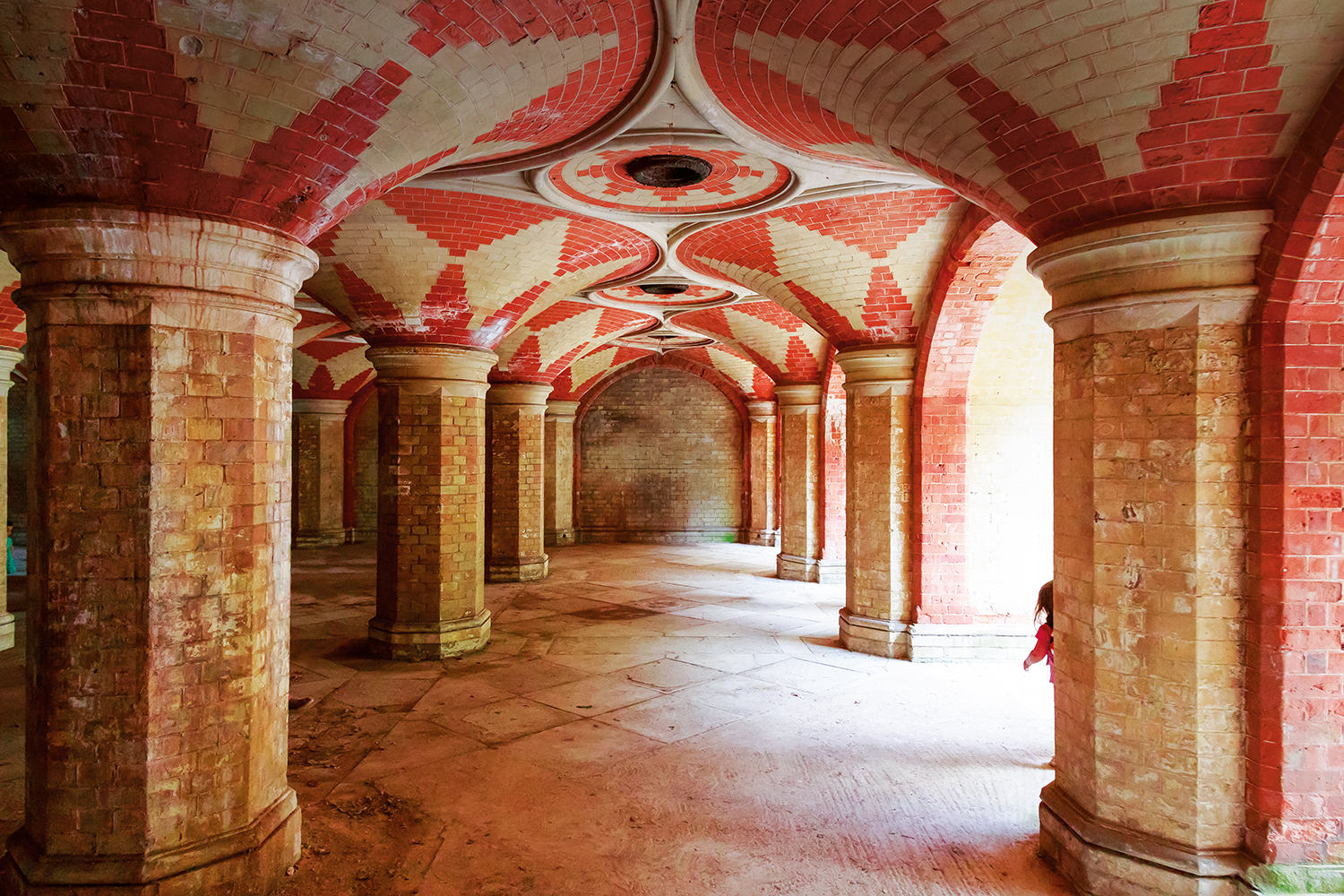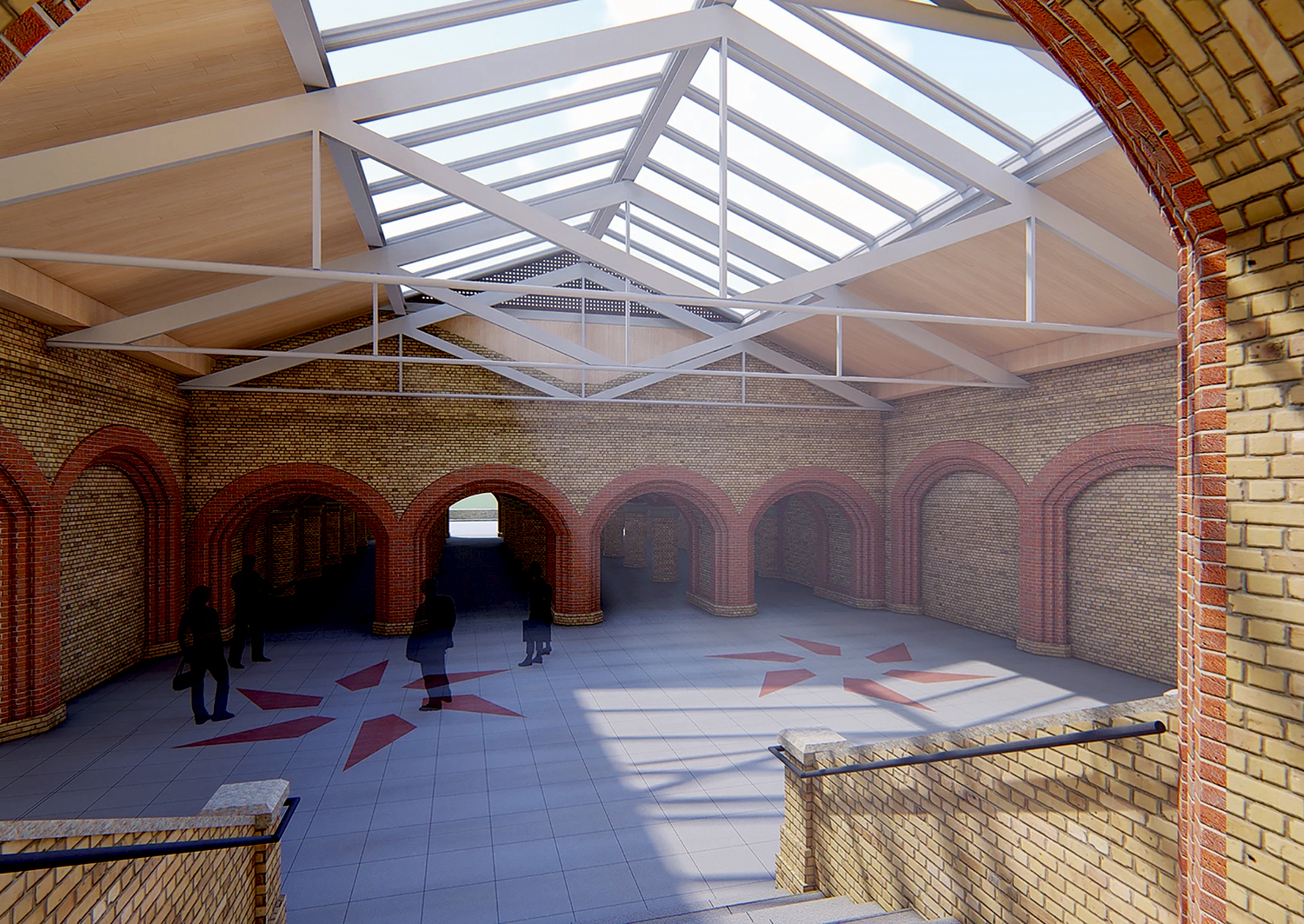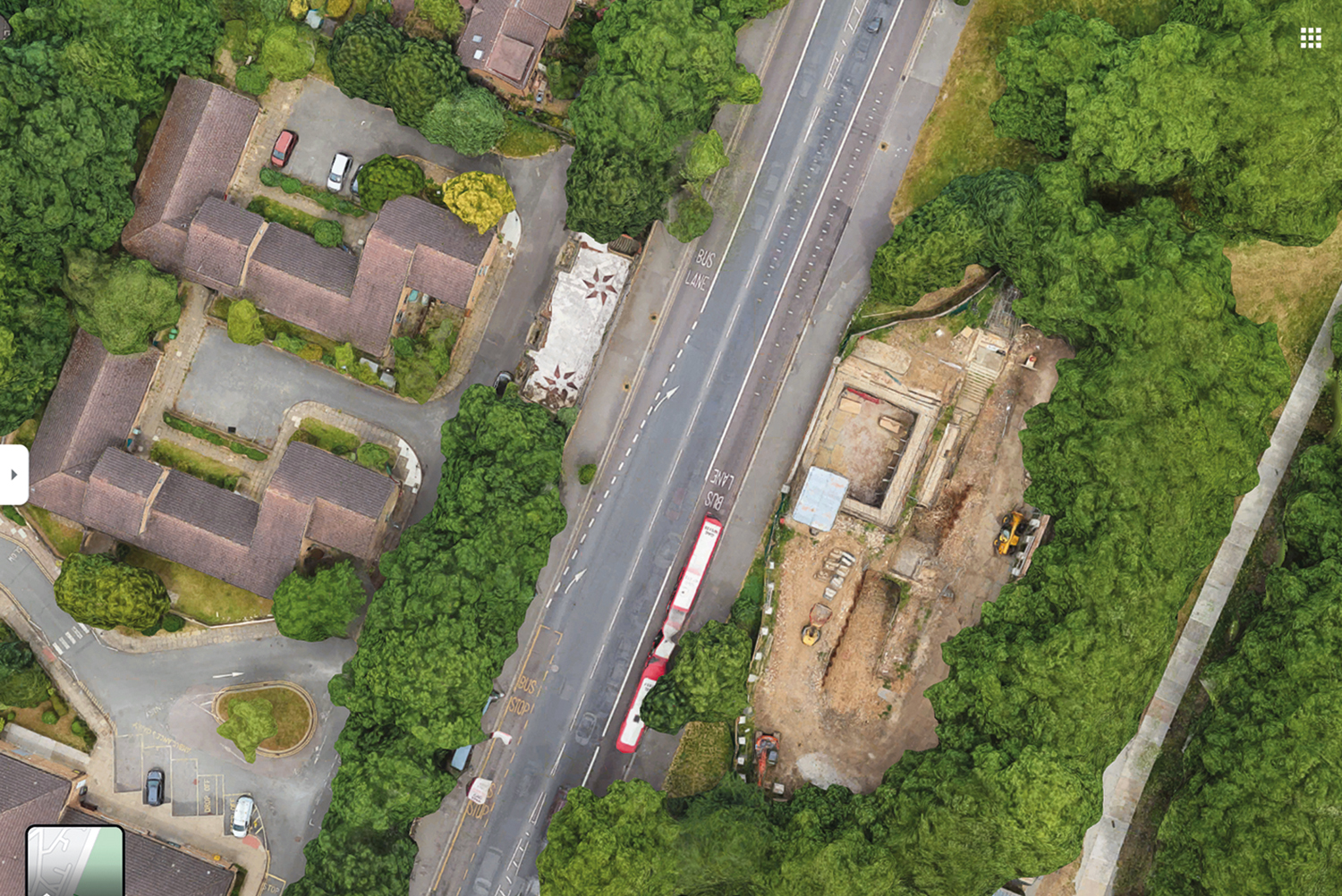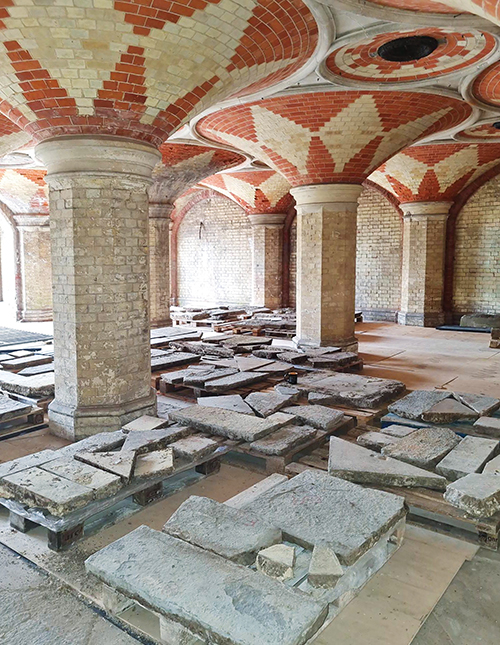
A grand Victorian underpass that once connected the Crystal Palace with a neighbouring station is being restored to its former glory. Will Mann reports from south London.
The Crystal Palace Subway is one of London’s hidden – and largely forgotten – subterranean treasures.
It was built in 1865 to give rail passengers alighting at the new High Level station a shortcut to the Crystal Palace, reassembled following the 1851 Great Exhibition in Hyde Park at a site on Sydenham Hill in south London.
Crystal Palace Subway restoration
Value: £3.2m
Programme: February 2022 to October 2023 (estimated)
Main contractor: DBR
Architect: Thomas Ford
Client team: Bromley Council; Historic England; Friends of Crystal Palace Subway
Civil engineer: CTP
Structural engineer: Morton
QS: IKS
The subway is a lavish legacy of the High Victorian architectural period. Designed and constructed by Italian cathedral specialists, its vaulted roof is supported by octagonal pillars faced with cream and terracotta bricks and tiling, which fan outwards as they climb to the ceiling.
Unfortunately, it was never as popular as was hoped. Public interest in the Crystal Palace dropped away in the late 19th century. It was destroyed by fire in 1936, and passenger numbers declined on the branch line serving the High Level station, which closed in 1954. The station – a cavernous structure with high brick-faced facades and four square towers at each corner of the entrance building – was demolished and redeveloped as housing.
But the subway survived. It lay derelict for half a century, until a group of local enthusiasts called the Friends of Crystal Palace Subway (FCPS) formed in 2013. They began exploring renovation options. In 2019, a £2.34m grant was secured from the City of London and £639,000 from Historic England, with FCPS chipping in £5,000.
Plans for renovation
In 2020, Thomas Ford & Partners was appointed as lead architect for the renovation and design of a new roof over the courtyard at the eastern end of the Grade II*-listed subway, with a view to turning this space into an events venue. Their work started with a detailed asset condition survey. In January 2022, Bromley council gave planning permission for the scheme and in February appointed heritage contractor DBR for the project.
The scope of DBR’s work includes repair of the Victorian subway station area, including cleaning of brickwork and rebuilding existing walls, construction of new parapet walls and the new roof structure over the courtyard.
When CM visits, the project is about three-quarters of the way to completion. The DBR site is accessed from the busy A212 – Crystal Palace Parade – on the western edge of the park. The old High Level station was on the other side of the road.
We are welcomed by DBR’s Talia Weiss, a trained conservator who also takes charge of the contractor’s marketing.

“Today is the 169th anniversary of Queen Victoria opening the Crystal Palace,” she tells us. “You’ve arrived via the same route as second- and third-class passengers, who had to go the long way round and cross the road to reach the Crystal Palace. First class passengers came through the subway.”
Retaining original materials
Although significant amounts of the stone and brickwork needed replacement, DBR has tried to retain as many of the original materials as possible, explains James Tarrant-Fisher, DBR’s project manager for the Crystal Palace Subway.
“That’s the ethos of any heritage or conservation project,” he says. “It’s also a sustainable approach. Where we’ve had to replace bricks, these are mostly reclaimed from brickyards, and we’ve tried to replicate the original materials to ensure what we’re using is sympathetic to the original design.

“Where we’ve had to replace bricks, these are mostly reclaimed from brickyards, and we’ve tried to replicate the original materials to ensure what we’re using is sympathetic to the design.”
“The FCPS have done an incredible job at collecting archive materials for the site to help us with the restoration.”
Before Thomas Ford’s asset condition survey, the site was overgrown and had to be cleared of vegetation.
Severe structural movement
The subway’s south staircase was almost completely buried – likely filled in shortly after World War II – and this was uncovered by excavations. The staircase’s lower section had suffered severe structural movement. Plant growth and ground pressures caused the west wall to almost completely collapse, and trees had taken root in the masonry. A reinforced concrete retaining wall, about a metre thick, has been constructed and ground anchors installed to retain the soil pressures.
Much of the lower south staircase had been removed, which Tarrant-Fisher describes as “puzzling” given each course of stone weighed 600kg. The stone that remained in situ was salvaged and used on other parts of the project, in line with conservation best practice. Sections of the vaulted subway were used as a salvage area for all the reclaimed stone.
“We had to completely replace the lower south staircase and the brickwork is being reconstructed with reclaimed bricks bedded in lime mortar,” Tarrant-Fisher says.
“These materials and techniques closely replicate the Victorian construction process.”


In contrast to the south, the north staircase lower section was largely intact. However, the stair treads suffered from poor quality cementitious repair and the walls of the upper flights had been badly damaged by exposure to the weather.
Conservation essential
“We have used some individual steps and landing stones salvaged from the south lower staircase to repair the north lower staircase,” says Tarrant-Fisher. “The largest landing stone exceeds one tonne in weight, a size no longer quarried, so conservation was essential.”
The north upper staircase was damaged beyond repair, so replacement was the only option, with the damaged brick walls reconstructed.

CPD at Crystal Palace
“DBR works hard to foster traditional craft skills on all our heritage projects, and we try to have as many apprentices on our projects as possible,” explains Talia Weiss.
“It was in the terms of our contract that we should employ apprentices on the Crystal Palace Subway, and we have two here: one bricklayer and one stonemason.
“We’ve also done a couple of CPD events at the site and we’re doing some school visits as well.
“It’s important we encourage the younger generation to take an interest in conservation projects such as this, so we can ensure heritage skills are not lost to the industry.”
From the staircase, we enter the courtyard. The original roof was dual-pitched, and the central gutter was supported by two columns that fetched off the courtyard floor.
However, architect Thomas Ford has opted for a different design for the new roof, which will be a simpler, pitched structure, made from steel and timber with a zinc covering.
“This avoids the difficulty of maintaining and draining a hidden valley gutter and removes the need for central columns, creating a clearer and more usable space in the courtyard,” says Weiss. “The roof will be glazed to allow natural lighting.”
Drainage routes
Although none of the original roof structure survives, excavation works have uncovered the original drainage routes, which were hidden in the courtyard walls. The rainwater outlets for the new roof will run on the surface of the courtyard walls and will be connected to the original Victorian drain runs that still exists below the courtyard.
“The courtyard paving is being repaired and reinstated where necessary, using the original layout and paving patterns,” says Tarrant-Fisher. “It was only once we excavated the area that we found the original paving was partly intact, so we will be relaying this pattern to keep the continuity. We lifted the courtyard paving stones and stored them in the subway, and as many as possible will be reinstated in their original locations.”
The courtyard floor will feature an elaborate radial pattern of ‘crystal shards’, which is also visible in the paving on the other side of the A212, where passengers arrived at the high-level station.
Next, we enter the spectacular fan-vaulted subway, which runs under the busy Crystal Palace Parade to the site of the old high-level station. “The octagonal structural columns show little evidence of any structural movement despite four lanes of traffic running overhead,” notes Tarrant-Fisher.
“The fan vaults serve both an aesthetical and functional purpose. The aesthetical element is there for all to see. What is unseen is the drainage system that the vaults encase. From undertaking surveys of the underground drainage, we noticed that there were laterals aligned with each column. Further investigation proved that each fan vault acts as a scupper draining the road above. This collects into vertical rainwater goods, connecting the scupper to the below ground drain.”

Remaking oak doors
The entrance to the park from the subway was through huge oak sliding doors, each weighing 500kg. Remnants of the doors’ structure, runners and tracks were found when Thomas Ford surveyed the site and DBR is relying on these clues plus archive photos and drawings to work out how the doors should be remade.
“These doors were slid across from apertures built into the brick walls, which are still intact,” explains Tarrant-Fisher. “The design of the runner system itself is very complicated, because the doors have to slide past each other. We are trying to replicate the original system as best we can. But it has been complicated by structural movement which means we’ve had to reduce the size of the sliding mechanism.
“The doors will be constructed in DBR’s timber workshop as two leaves. These will be hung separately and jointed in situ. The doors will be hung via mechanical means; they are too large to be lifted manually into position.”
DBR’s project team on the subway – which peaked at 30 – will complete their work this autumn. The trains may have long departed, but this grand vestige of Victoriana will soon be open to the public once again.
Comments
Comments are closed.












Fascinating article, Will. How soon is soon? Do we have an opening date.